Assignment on International Relations 1
VerifiedAdded on 2022/10/04
|10
|2955
|14
Assignment
AI Summary
Contribute Materials
Your contribution can guide someone’s learning journey. Share your
documents today.
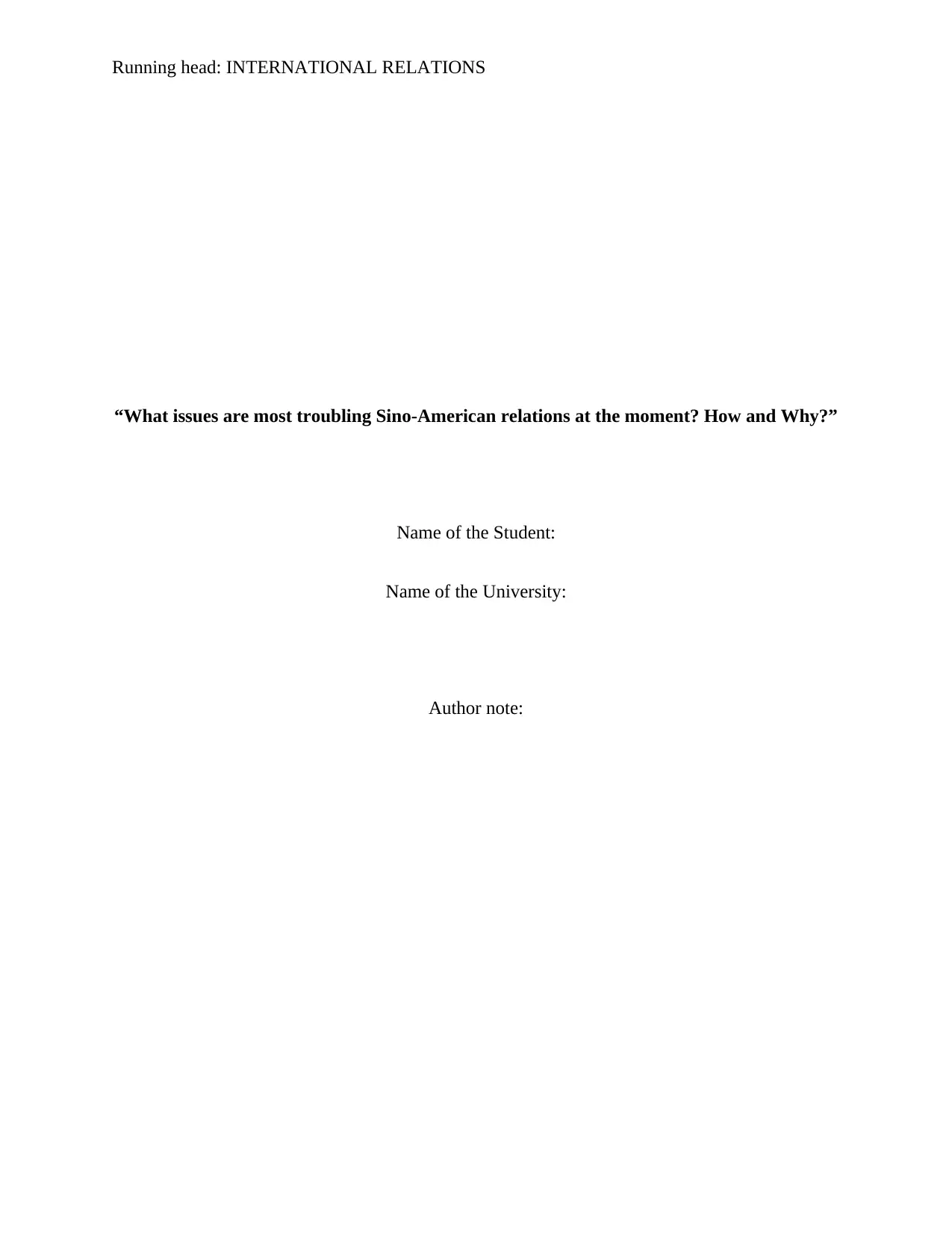
Running head: INTERNATIONAL RELATIONS
“What issues are most troubling Sino-American relations at the moment? How and Why?”
Name of the Student:
Name of the University:
Author note:
“What issues are most troubling Sino-American relations at the moment? How and Why?”
Name of the Student:
Name of the University:
Author note:
Secure Best Marks with AI Grader
Need help grading? Try our AI Grader for instant feedback on your assignments.
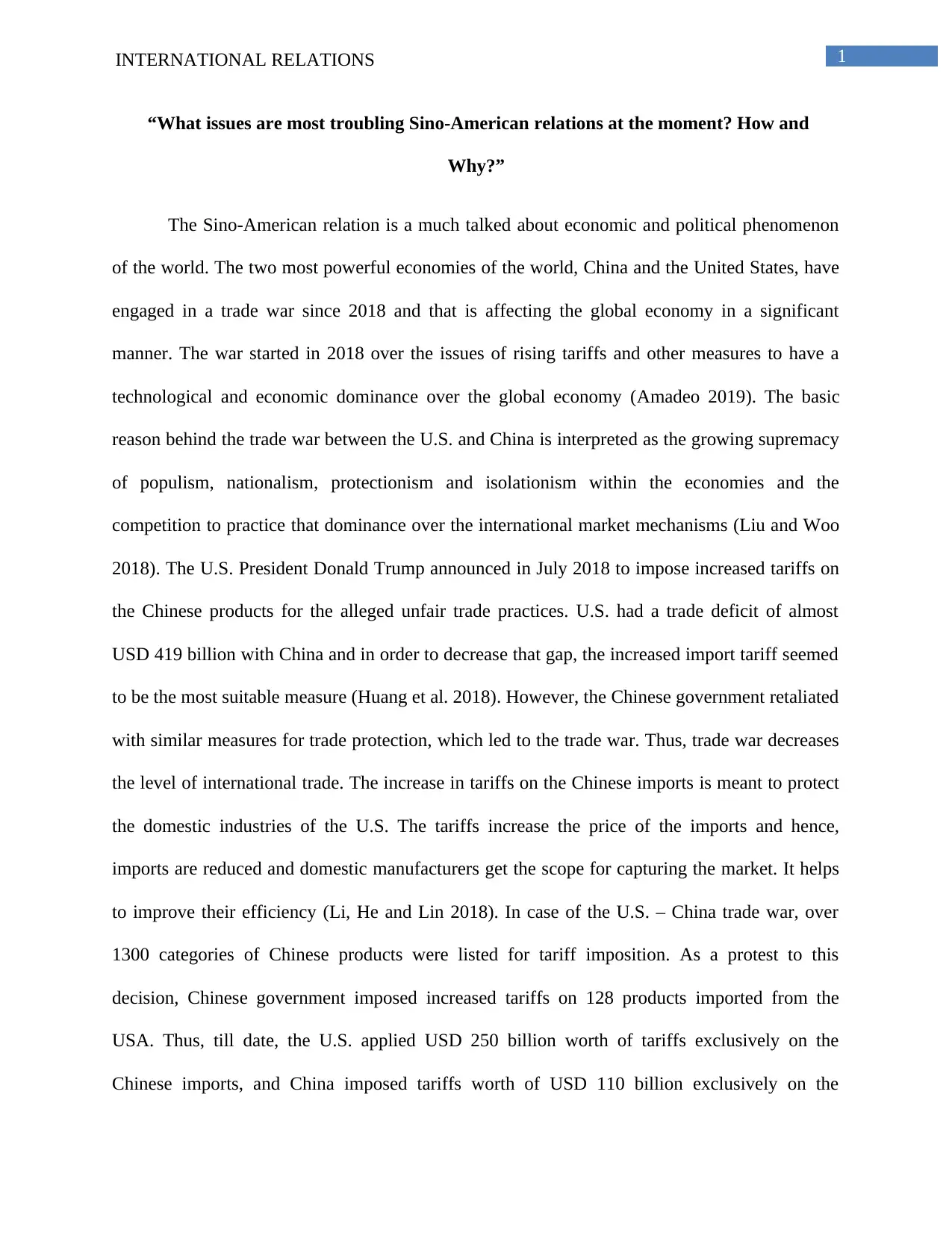
1INTERNATIONAL RELATIONS
“What issues are most troubling Sino-American relations at the moment? How and
Why?”
The Sino-American relation is a much talked about economic and political phenomenon
of the world. The two most powerful economies of the world, China and the United States, have
engaged in a trade war since 2018 and that is affecting the global economy in a significant
manner. The war started in 2018 over the issues of rising tariffs and other measures to have a
technological and economic dominance over the global economy (Amadeo 2019). The basic
reason behind the trade war between the U.S. and China is interpreted as the growing supremacy
of populism, nationalism, protectionism and isolationism within the economies and the
competition to practice that dominance over the international market mechanisms (Liu and Woo
2018). The U.S. President Donald Trump announced in July 2018 to impose increased tariffs on
the Chinese products for the alleged unfair trade practices. U.S. had a trade deficit of almost
USD 419 billion with China and in order to decrease that gap, the increased import tariff seemed
to be the most suitable measure (Huang et al. 2018). However, the Chinese government retaliated
with similar measures for trade protection, which led to the trade war. Thus, trade war decreases
the level of international trade. The increase in tariffs on the Chinese imports is meant to protect
the domestic industries of the U.S. The tariffs increase the price of the imports and hence,
imports are reduced and domestic manufacturers get the scope for capturing the market. It helps
to improve their efficiency (Li, He and Lin 2018). In case of the U.S. – China trade war, over
1300 categories of Chinese products were listed for tariff imposition. As a protest to this
decision, Chinese government imposed increased tariffs on 128 products imported from the
USA. Thus, till date, the U.S. applied USD 250 billion worth of tariffs exclusively on the
Chinese imports, and China imposed tariffs worth of USD 110 billion exclusively on the
“What issues are most troubling Sino-American relations at the moment? How and
Why?”
The Sino-American relation is a much talked about economic and political phenomenon
of the world. The two most powerful economies of the world, China and the United States, have
engaged in a trade war since 2018 and that is affecting the global economy in a significant
manner. The war started in 2018 over the issues of rising tariffs and other measures to have a
technological and economic dominance over the global economy (Amadeo 2019). The basic
reason behind the trade war between the U.S. and China is interpreted as the growing supremacy
of populism, nationalism, protectionism and isolationism within the economies and the
competition to practice that dominance over the international market mechanisms (Liu and Woo
2018). The U.S. President Donald Trump announced in July 2018 to impose increased tariffs on
the Chinese products for the alleged unfair trade practices. U.S. had a trade deficit of almost
USD 419 billion with China and in order to decrease that gap, the increased import tariff seemed
to be the most suitable measure (Huang et al. 2018). However, the Chinese government retaliated
with similar measures for trade protection, which led to the trade war. Thus, trade war decreases
the level of international trade. The increase in tariffs on the Chinese imports is meant to protect
the domestic industries of the U.S. The tariffs increase the price of the imports and hence,
imports are reduced and domestic manufacturers get the scope for capturing the market. It helps
to improve their efficiency (Li, He and Lin 2018). In case of the U.S. – China trade war, over
1300 categories of Chinese products were listed for tariff imposition. As a protest to this
decision, Chinese government imposed increased tariffs on 128 products imported from the
USA. Thus, till date, the U.S. applied USD 250 billion worth of tariffs exclusively on the
Chinese imports, and China imposed tariffs worth of USD 110 billion exclusively on the
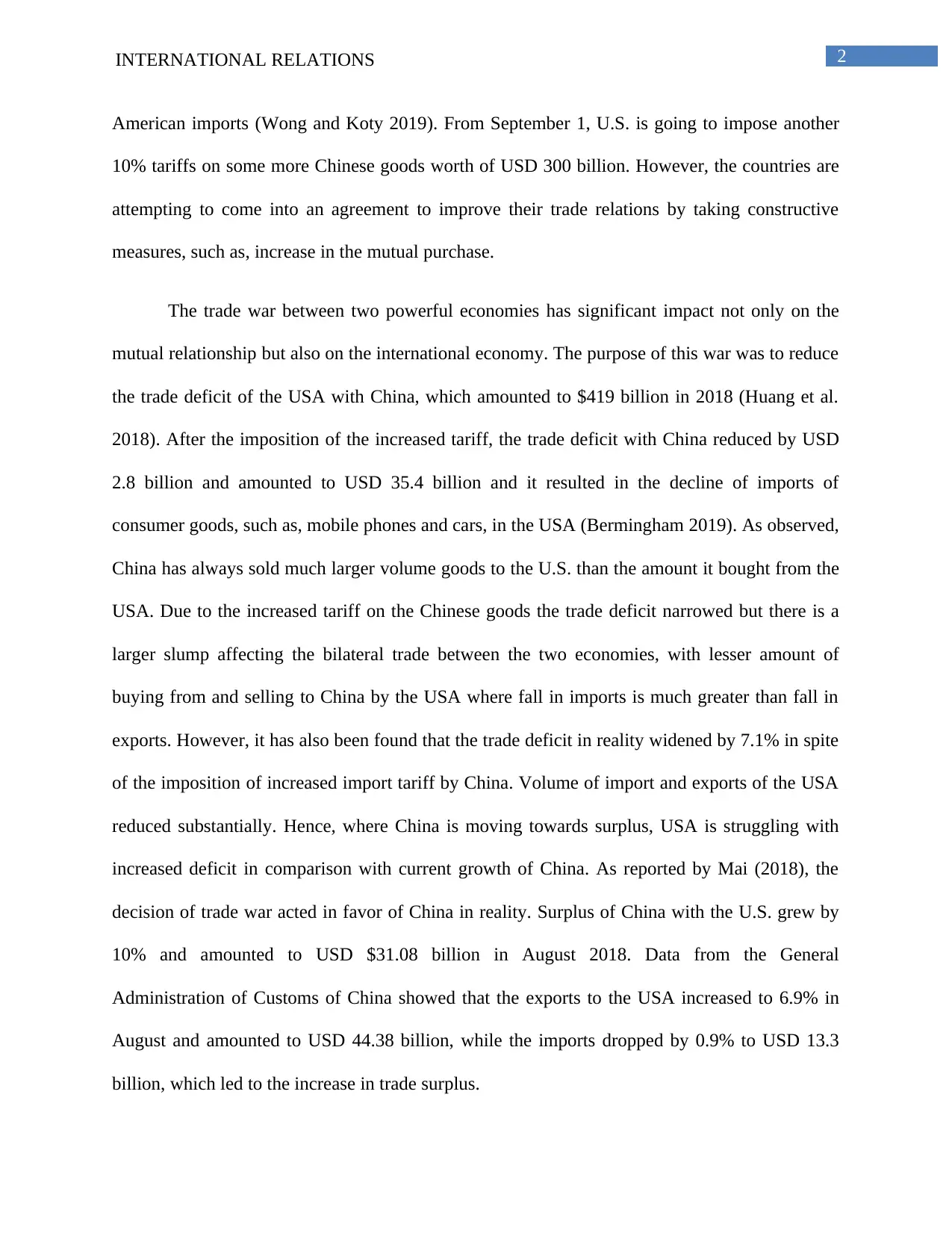
2INTERNATIONAL RELATIONS
American imports (Wong and Koty 2019). From September 1, U.S. is going to impose another
10% tariffs on some more Chinese goods worth of USD 300 billion. However, the countries are
attempting to come into an agreement to improve their trade relations by taking constructive
measures, such as, increase in the mutual purchase.
The trade war between two powerful economies has significant impact not only on the
mutual relationship but also on the international economy. The purpose of this war was to reduce
the trade deficit of the USA with China, which amounted to $419 billion in 2018 (Huang et al.
2018). After the imposition of the increased tariff, the trade deficit with China reduced by USD
2.8 billion and amounted to USD 35.4 billion and it resulted in the decline of imports of
consumer goods, such as, mobile phones and cars, in the USA (Bermingham 2019). As observed,
China has always sold much larger volume goods to the U.S. than the amount it bought from the
USA. Due to the increased tariff on the Chinese goods the trade deficit narrowed but there is a
larger slump affecting the bilateral trade between the two economies, with lesser amount of
buying from and selling to China by the USA where fall in imports is much greater than fall in
exports. However, it has also been found that the trade deficit in reality widened by 7.1% in spite
of the imposition of increased import tariff by China. Volume of import and exports of the USA
reduced substantially. Hence, where China is moving towards surplus, USA is struggling with
increased deficit in comparison with current growth of China. As reported by Mai (2018), the
decision of trade war acted in favor of China in reality. Surplus of China with the U.S. grew by
10% and amounted to USD $31.08 billion in August 2018. Data from the General
Administration of Customs of China showed that the exports to the USA increased to 6.9% in
August and amounted to USD 44.38 billion, while the imports dropped by 0.9% to USD 13.3
billion, which led to the increase in trade surplus.
American imports (Wong and Koty 2019). From September 1, U.S. is going to impose another
10% tariffs on some more Chinese goods worth of USD 300 billion. However, the countries are
attempting to come into an agreement to improve their trade relations by taking constructive
measures, such as, increase in the mutual purchase.
The trade war between two powerful economies has significant impact not only on the
mutual relationship but also on the international economy. The purpose of this war was to reduce
the trade deficit of the USA with China, which amounted to $419 billion in 2018 (Huang et al.
2018). After the imposition of the increased tariff, the trade deficit with China reduced by USD
2.8 billion and amounted to USD 35.4 billion and it resulted in the decline of imports of
consumer goods, such as, mobile phones and cars, in the USA (Bermingham 2019). As observed,
China has always sold much larger volume goods to the U.S. than the amount it bought from the
USA. Due to the increased tariff on the Chinese goods the trade deficit narrowed but there is a
larger slump affecting the bilateral trade between the two economies, with lesser amount of
buying from and selling to China by the USA where fall in imports is much greater than fall in
exports. However, it has also been found that the trade deficit in reality widened by 7.1% in spite
of the imposition of increased import tariff by China. Volume of import and exports of the USA
reduced substantially. Hence, where China is moving towards surplus, USA is struggling with
increased deficit in comparison with current growth of China. As reported by Mai (2018), the
decision of trade war acted in favor of China in reality. Surplus of China with the U.S. grew by
10% and amounted to USD $31.08 billion in August 2018. Data from the General
Administration of Customs of China showed that the exports to the USA increased to 6.9% in
August and amounted to USD 44.38 billion, while the imports dropped by 0.9% to USD 13.3
billion, which led to the increase in trade surplus.
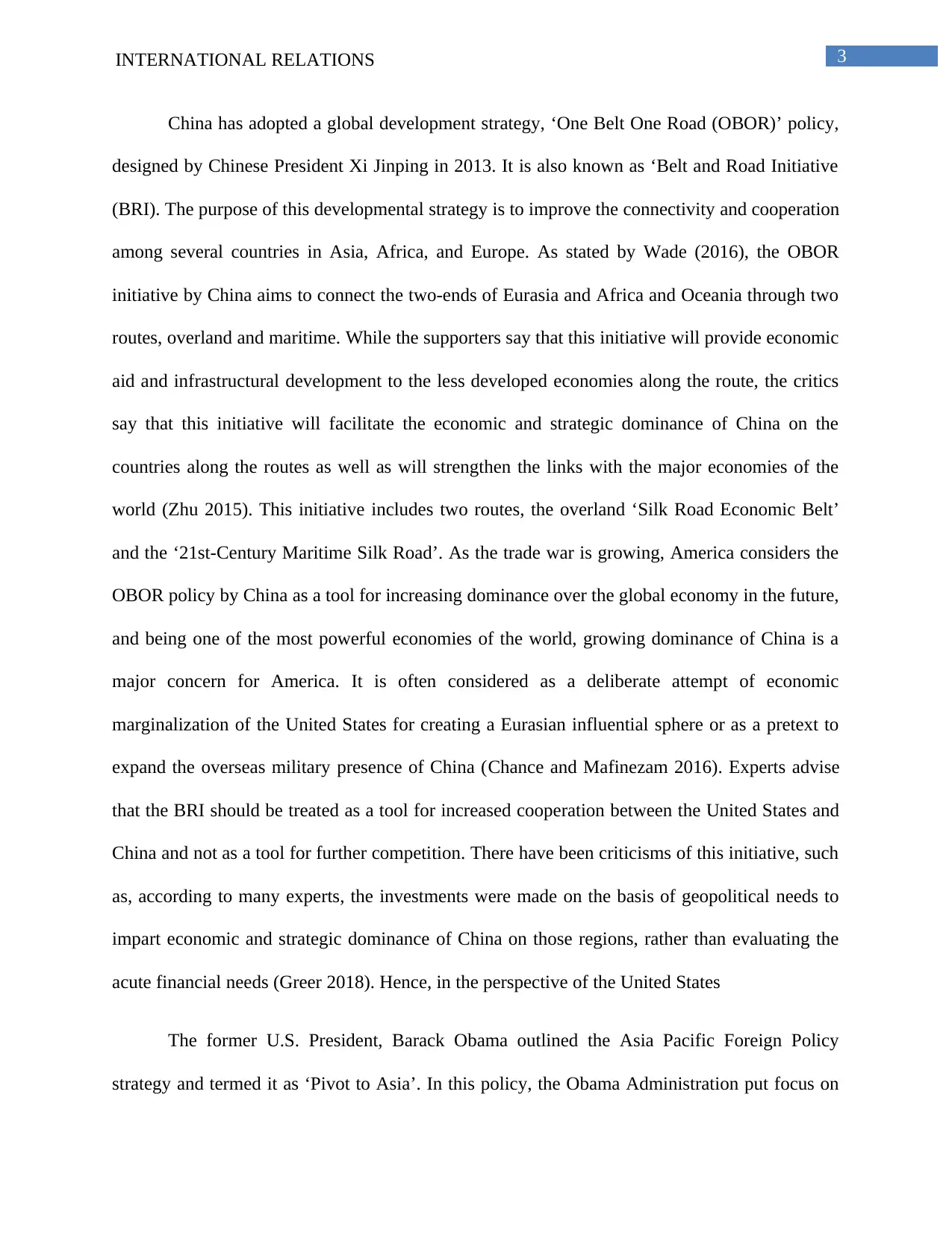
3INTERNATIONAL RELATIONS
China has adopted a global development strategy, ‘One Belt One Road (OBOR)’ policy,
designed by Chinese President Xi Jinping in 2013. It is also known as ‘Belt and Road Initiative
(BRI). The purpose of this developmental strategy is to improve the connectivity and cooperation
among several countries in Asia, Africa, and Europe. As stated by Wade (2016), the OBOR
initiative by China aims to connect the two-ends of Eurasia and Africa and Oceania through two
routes, overland and maritime. While the supporters say that this initiative will provide economic
aid and infrastructural development to the less developed economies along the route, the critics
say that this initiative will facilitate the economic and strategic dominance of China on the
countries along the routes as well as will strengthen the links with the major economies of the
world (Zhu 2015). This initiative includes two routes, the overland ‘Silk Road Economic Belt’
and the ‘21st-Century Maritime Silk Road’. As the trade war is growing, America considers the
OBOR policy by China as a tool for increasing dominance over the global economy in the future,
and being one of the most powerful economies of the world, growing dominance of China is a
major concern for America. It is often considered as a deliberate attempt of economic
marginalization of the United States for creating a Eurasian influential sphere or as a pretext to
expand the overseas military presence of China (Chance and Mafinezam 2016). Experts advise
that the BRI should be treated as a tool for increased cooperation between the United States and
China and not as a tool for further competition. There have been criticisms of this initiative, such
as, according to many experts, the investments were made on the basis of geopolitical needs to
impart economic and strategic dominance of China on those regions, rather than evaluating the
acute financial needs (Greer 2018). Hence, in the perspective of the United States
The former U.S. President, Barack Obama outlined the Asia Pacific Foreign Policy
strategy and termed it as ‘Pivot to Asia’. In this policy, the Obama Administration put focus on
China has adopted a global development strategy, ‘One Belt One Road (OBOR)’ policy,
designed by Chinese President Xi Jinping in 2013. It is also known as ‘Belt and Road Initiative
(BRI). The purpose of this developmental strategy is to improve the connectivity and cooperation
among several countries in Asia, Africa, and Europe. As stated by Wade (2016), the OBOR
initiative by China aims to connect the two-ends of Eurasia and Africa and Oceania through two
routes, overland and maritime. While the supporters say that this initiative will provide economic
aid and infrastructural development to the less developed economies along the route, the critics
say that this initiative will facilitate the economic and strategic dominance of China on the
countries along the routes as well as will strengthen the links with the major economies of the
world (Zhu 2015). This initiative includes two routes, the overland ‘Silk Road Economic Belt’
and the ‘21st-Century Maritime Silk Road’. As the trade war is growing, America considers the
OBOR policy by China as a tool for increasing dominance over the global economy in the future,
and being one of the most powerful economies of the world, growing dominance of China is a
major concern for America. It is often considered as a deliberate attempt of economic
marginalization of the United States for creating a Eurasian influential sphere or as a pretext to
expand the overseas military presence of China (Chance and Mafinezam 2016). Experts advise
that the BRI should be treated as a tool for increased cooperation between the United States and
China and not as a tool for further competition. There have been criticisms of this initiative, such
as, according to many experts, the investments were made on the basis of geopolitical needs to
impart economic and strategic dominance of China on those regions, rather than evaluating the
acute financial needs (Greer 2018). Hence, in the perspective of the United States
The former U.S. President, Barack Obama outlined the Asia Pacific Foreign Policy
strategy and termed it as ‘Pivot to Asia’. In this policy, the Obama Administration put focus on
Secure Best Marks with AI Grader
Need help grading? Try our AI Grader for instant feedback on your assignments.
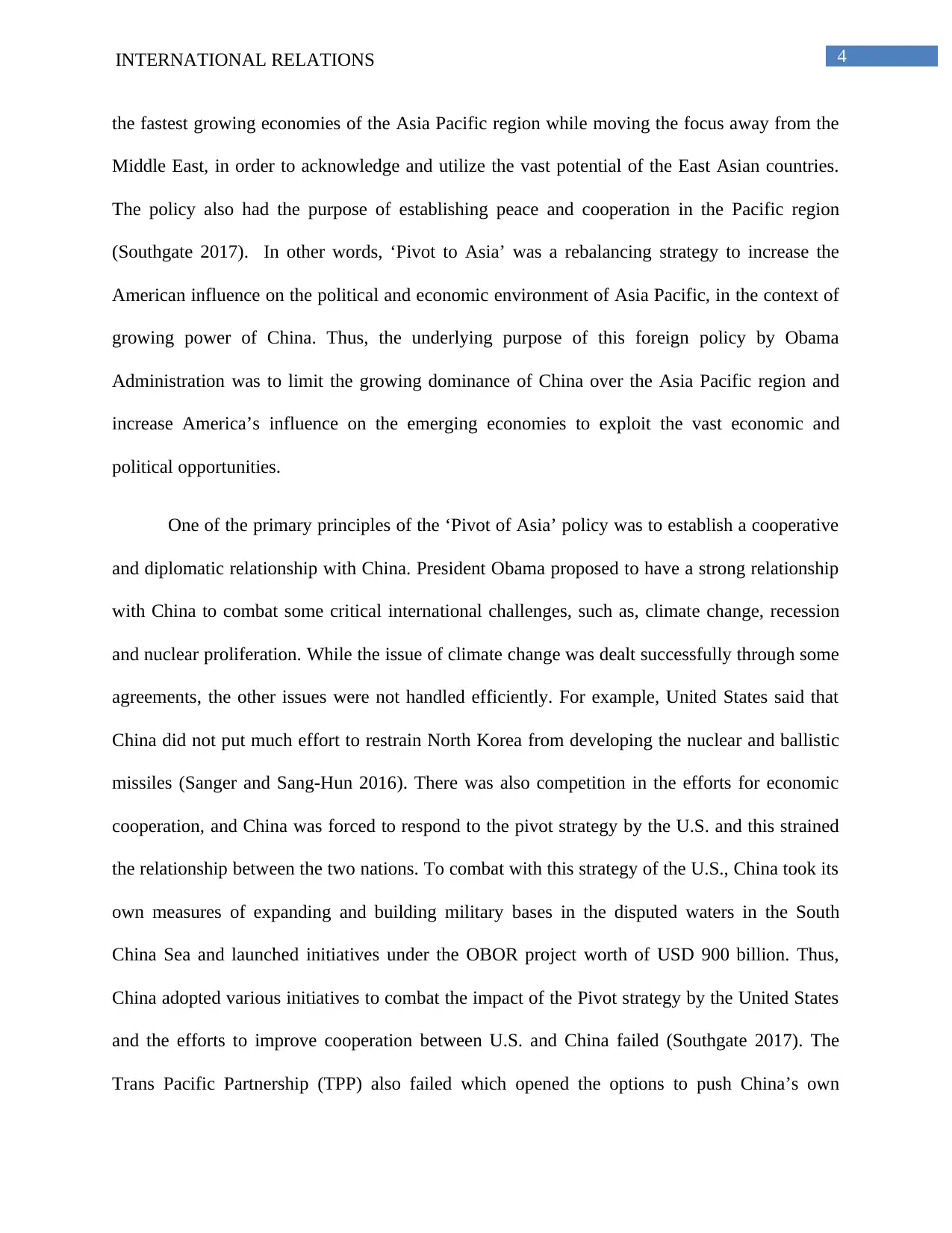
4INTERNATIONAL RELATIONS
the fastest growing economies of the Asia Pacific region while moving the focus away from the
Middle East, in order to acknowledge and utilize the vast potential of the East Asian countries.
The policy also had the purpose of establishing peace and cooperation in the Pacific region
(Southgate 2017). In other words, ‘Pivot to Asia’ was a rebalancing strategy to increase the
American influence on the political and economic environment of Asia Pacific, in the context of
growing power of China. Thus, the underlying purpose of this foreign policy by Obama
Administration was to limit the growing dominance of China over the Asia Pacific region and
increase America’s influence on the emerging economies to exploit the vast economic and
political opportunities.
One of the primary principles of the ‘Pivot of Asia’ policy was to establish a cooperative
and diplomatic relationship with China. President Obama proposed to have a strong relationship
with China to combat some critical international challenges, such as, climate change, recession
and nuclear proliferation. While the issue of climate change was dealt successfully through some
agreements, the other issues were not handled efficiently. For example, United States said that
China did not put much effort to restrain North Korea from developing the nuclear and ballistic
missiles (Sanger and Sang-Hun 2016). There was also competition in the efforts for economic
cooperation, and China was forced to respond to the pivot strategy by the U.S. and this strained
the relationship between the two nations. To combat with this strategy of the U.S., China took its
own measures of expanding and building military bases in the disputed waters in the South
China Sea and launched initiatives under the OBOR project worth of USD 900 billion. Thus,
China adopted various initiatives to combat the impact of the Pivot strategy by the United States
and the efforts to improve cooperation between U.S. and China failed (Southgate 2017). The
Trans Pacific Partnership (TPP) also failed which opened the options to push China’s own
the fastest growing economies of the Asia Pacific region while moving the focus away from the
Middle East, in order to acknowledge and utilize the vast potential of the East Asian countries.
The policy also had the purpose of establishing peace and cooperation in the Pacific region
(Southgate 2017). In other words, ‘Pivot to Asia’ was a rebalancing strategy to increase the
American influence on the political and economic environment of Asia Pacific, in the context of
growing power of China. Thus, the underlying purpose of this foreign policy by Obama
Administration was to limit the growing dominance of China over the Asia Pacific region and
increase America’s influence on the emerging economies to exploit the vast economic and
political opportunities.
One of the primary principles of the ‘Pivot of Asia’ policy was to establish a cooperative
and diplomatic relationship with China. President Obama proposed to have a strong relationship
with China to combat some critical international challenges, such as, climate change, recession
and nuclear proliferation. While the issue of climate change was dealt successfully through some
agreements, the other issues were not handled efficiently. For example, United States said that
China did not put much effort to restrain North Korea from developing the nuclear and ballistic
missiles (Sanger and Sang-Hun 2016). There was also competition in the efforts for economic
cooperation, and China was forced to respond to the pivot strategy by the U.S. and this strained
the relationship between the two nations. To combat with this strategy of the U.S., China took its
own measures of expanding and building military bases in the disputed waters in the South
China Sea and launched initiatives under the OBOR project worth of USD 900 billion. Thus,
China adopted various initiatives to combat the impact of the Pivot strategy by the United States
and the efforts to improve cooperation between U.S. and China failed (Southgate 2017). The
Trans Pacific Partnership (TPP) also failed which opened the options to push China’s own
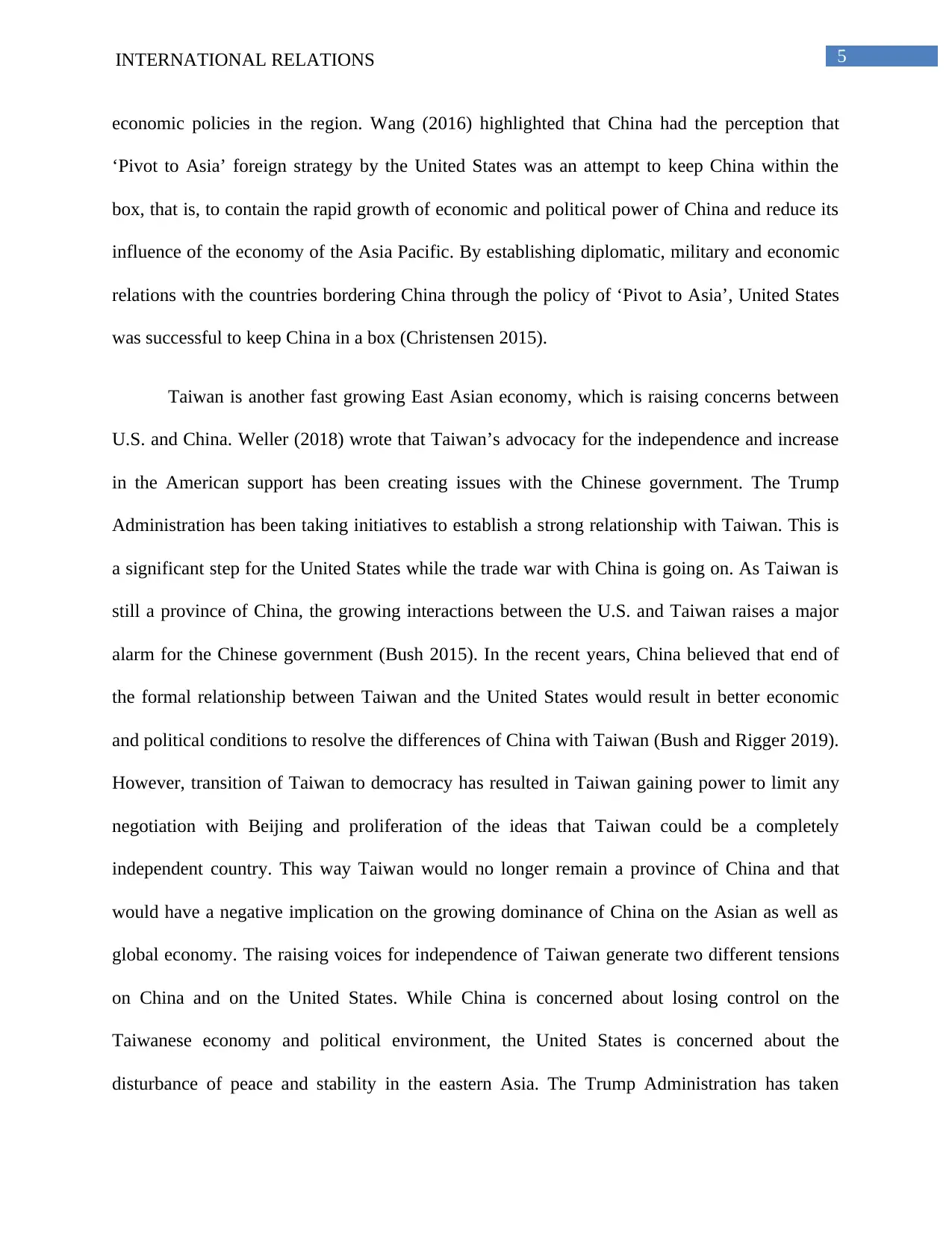
5INTERNATIONAL RELATIONS
economic policies in the region. Wang (2016) highlighted that China had the perception that
‘Pivot to Asia’ foreign strategy by the United States was an attempt to keep China within the
box, that is, to contain the rapid growth of economic and political power of China and reduce its
influence of the economy of the Asia Pacific. By establishing diplomatic, military and economic
relations with the countries bordering China through the policy of ‘Pivot to Asia’, United States
was successful to keep China in a box (Christensen 2015).
Taiwan is another fast growing East Asian economy, which is raising concerns between
U.S. and China. Weller (2018) wrote that Taiwan’s advocacy for the independence and increase
in the American support has been creating issues with the Chinese government. The Trump
Administration has been taking initiatives to establish a strong relationship with Taiwan. This is
a significant step for the United States while the trade war with China is going on. As Taiwan is
still a province of China, the growing interactions between the U.S. and Taiwan raises a major
alarm for the Chinese government (Bush 2015). In the recent years, China believed that end of
the formal relationship between Taiwan and the United States would result in better economic
and political conditions to resolve the differences of China with Taiwan (Bush and Rigger 2019).
However, transition of Taiwan to democracy has resulted in Taiwan gaining power to limit any
negotiation with Beijing and proliferation of the ideas that Taiwan could be a completely
independent country. This way Taiwan would no longer remain a province of China and that
would have a negative implication on the growing dominance of China on the Asian as well as
global economy. The raising voices for independence of Taiwan generate two different tensions
on China and on the United States. While China is concerned about losing control on the
Taiwanese economy and political environment, the United States is concerned about the
disturbance of peace and stability in the eastern Asia. The Trump Administration has taken
economic policies in the region. Wang (2016) highlighted that China had the perception that
‘Pivot to Asia’ foreign strategy by the United States was an attempt to keep China within the
box, that is, to contain the rapid growth of economic and political power of China and reduce its
influence of the economy of the Asia Pacific. By establishing diplomatic, military and economic
relations with the countries bordering China through the policy of ‘Pivot to Asia’, United States
was successful to keep China in a box (Christensen 2015).
Taiwan is another fast growing East Asian economy, which is raising concerns between
U.S. and China. Weller (2018) wrote that Taiwan’s advocacy for the independence and increase
in the American support has been creating issues with the Chinese government. The Trump
Administration has been taking initiatives to establish a strong relationship with Taiwan. This is
a significant step for the United States while the trade war with China is going on. As Taiwan is
still a province of China, the growing interactions between the U.S. and Taiwan raises a major
alarm for the Chinese government (Bush 2015). In the recent years, China believed that end of
the formal relationship between Taiwan and the United States would result in better economic
and political conditions to resolve the differences of China with Taiwan (Bush and Rigger 2019).
However, transition of Taiwan to democracy has resulted in Taiwan gaining power to limit any
negotiation with Beijing and proliferation of the ideas that Taiwan could be a completely
independent country. This way Taiwan would no longer remain a province of China and that
would have a negative implication on the growing dominance of China on the Asian as well as
global economy. The raising voices for independence of Taiwan generate two different tensions
on China and on the United States. While China is concerned about losing control on the
Taiwanese economy and political environment, the United States is concerned about the
disturbance of peace and stability in the eastern Asia. The Trump Administration has taken
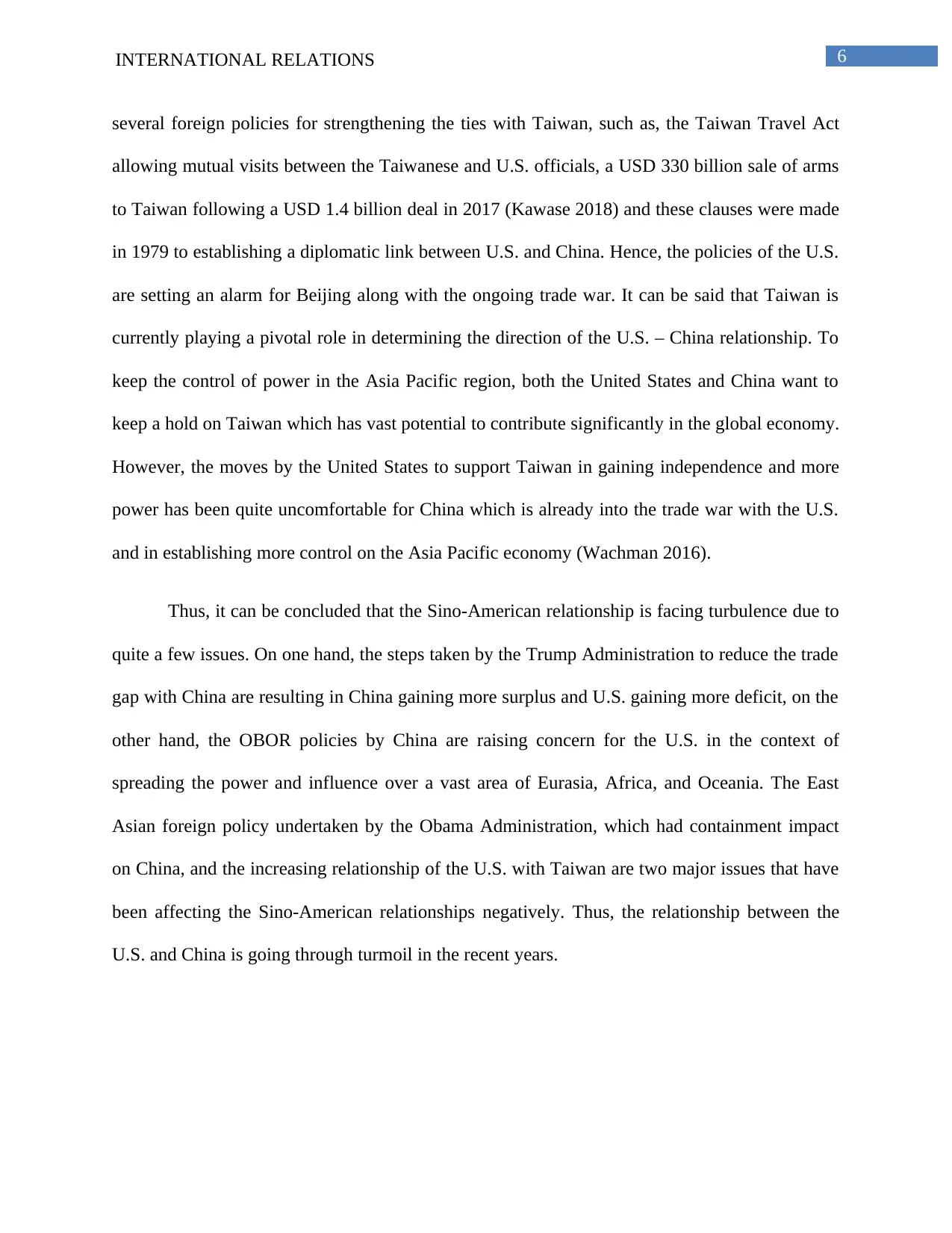
6INTERNATIONAL RELATIONS
several foreign policies for strengthening the ties with Taiwan, such as, the Taiwan Travel Act
allowing mutual visits between the Taiwanese and U.S. officials, a USD 330 billion sale of arms
to Taiwan following a USD 1.4 billion deal in 2017 (Kawase 2018) and these clauses were made
in 1979 to establishing a diplomatic link between U.S. and China. Hence, the policies of the U.S.
are setting an alarm for Beijing along with the ongoing trade war. It can be said that Taiwan is
currently playing a pivotal role in determining the direction of the U.S. – China relationship. To
keep the control of power in the Asia Pacific region, both the United States and China want to
keep a hold on Taiwan which has vast potential to contribute significantly in the global economy.
However, the moves by the United States to support Taiwan in gaining independence and more
power has been quite uncomfortable for China which is already into the trade war with the U.S.
and in establishing more control on the Asia Pacific economy (Wachman 2016).
Thus, it can be concluded that the Sino-American relationship is facing turbulence due to
quite a few issues. On one hand, the steps taken by the Trump Administration to reduce the trade
gap with China are resulting in China gaining more surplus and U.S. gaining more deficit, on the
other hand, the OBOR policies by China are raising concern for the U.S. in the context of
spreading the power and influence over a vast area of Eurasia, Africa, and Oceania. The East
Asian foreign policy undertaken by the Obama Administration, which had containment impact
on China, and the increasing relationship of the U.S. with Taiwan are two major issues that have
been affecting the Sino-American relationships negatively. Thus, the relationship between the
U.S. and China is going through turmoil in the recent years.
several foreign policies for strengthening the ties with Taiwan, such as, the Taiwan Travel Act
allowing mutual visits between the Taiwanese and U.S. officials, a USD 330 billion sale of arms
to Taiwan following a USD 1.4 billion deal in 2017 (Kawase 2018) and these clauses were made
in 1979 to establishing a diplomatic link between U.S. and China. Hence, the policies of the U.S.
are setting an alarm for Beijing along with the ongoing trade war. It can be said that Taiwan is
currently playing a pivotal role in determining the direction of the U.S. – China relationship. To
keep the control of power in the Asia Pacific region, both the United States and China want to
keep a hold on Taiwan which has vast potential to contribute significantly in the global economy.
However, the moves by the United States to support Taiwan in gaining independence and more
power has been quite uncomfortable for China which is already into the trade war with the U.S.
and in establishing more control on the Asia Pacific economy (Wachman 2016).
Thus, it can be concluded that the Sino-American relationship is facing turbulence due to
quite a few issues. On one hand, the steps taken by the Trump Administration to reduce the trade
gap with China are resulting in China gaining more surplus and U.S. gaining more deficit, on the
other hand, the OBOR policies by China are raising concern for the U.S. in the context of
spreading the power and influence over a vast area of Eurasia, Africa, and Oceania. The East
Asian foreign policy undertaken by the Obama Administration, which had containment impact
on China, and the increasing relationship of the U.S. with Taiwan are two major issues that have
been affecting the Sino-American relationships negatively. Thus, the relationship between the
U.S. and China is going through turmoil in the recent years.
Paraphrase This Document
Need a fresh take? Get an instant paraphrase of this document with our AI Paraphraser
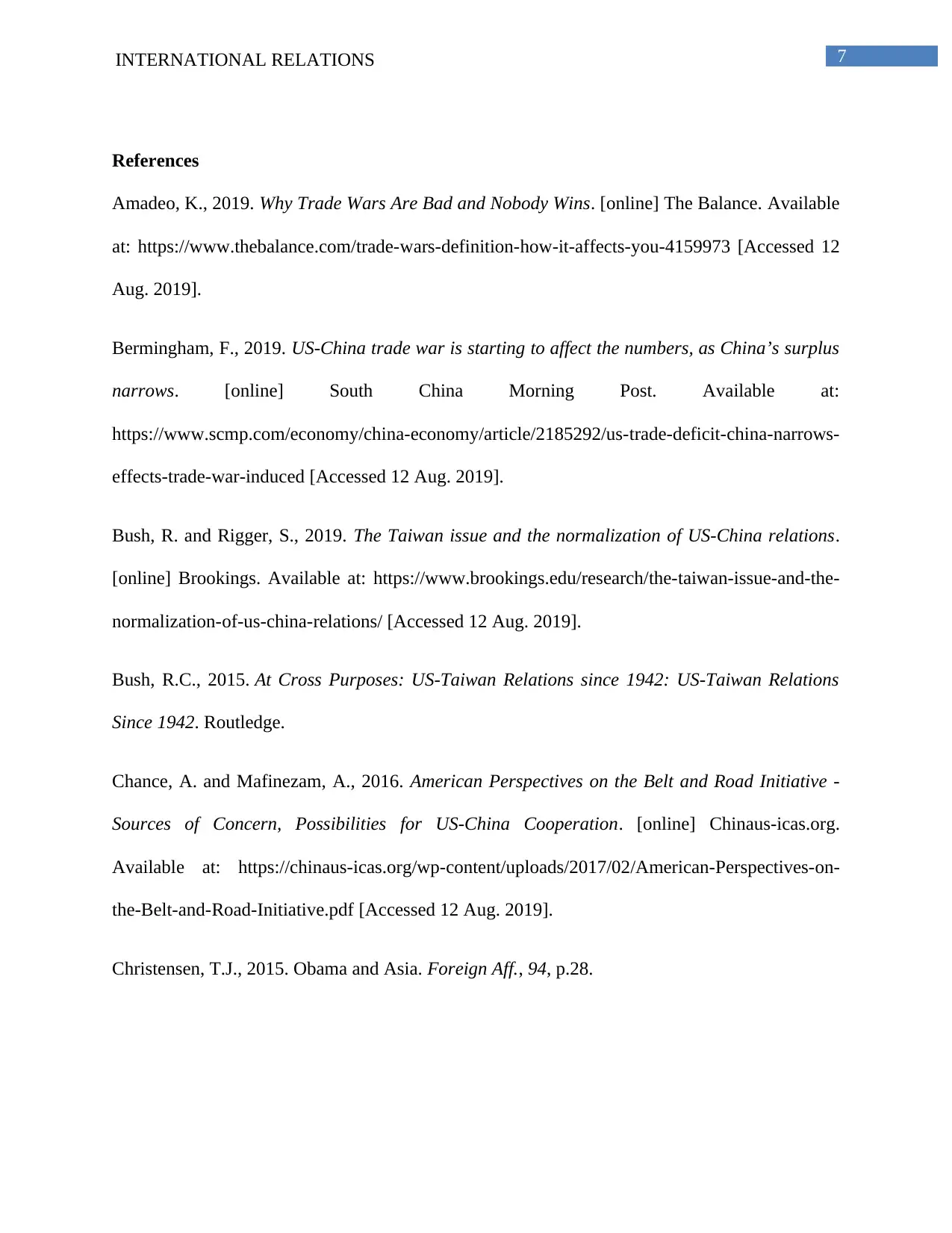
7INTERNATIONAL RELATIONS
References
Amadeo, K., 2019. Why Trade Wars Are Bad and Nobody Wins. [online] The Balance. Available
at: https://www.thebalance.com/trade-wars-definition-how-it-affects-you-4159973 [Accessed 12
Aug. 2019].
Bermingham, F., 2019. US-China trade war is starting to affect the numbers, as China’s surplus
narrows. [online] South China Morning Post. Available at:
https://www.scmp.com/economy/china-economy/article/2185292/us-trade-deficit-china-narrows-
effects-trade-war-induced [Accessed 12 Aug. 2019].
Bush, R. and Rigger, S., 2019. The Taiwan issue and the normalization of US-China relations.
[online] Brookings. Available at: https://www.brookings.edu/research/the-taiwan-issue-and-the-
normalization-of-us-china-relations/ [Accessed 12 Aug. 2019].
Bush, R.C., 2015. At Cross Purposes: US-Taiwan Relations since 1942: US-Taiwan Relations
Since 1942. Routledge.
Chance, A. and Mafinezam, A., 2016. American Perspectives on the Belt and Road Initiative -
Sources of Concern, Possibilities for US-China Cooperation. [online] Chinaus-icas.org.
Available at: https://chinaus-icas.org/wp-content/uploads/2017/02/American-Perspectives-on-
the-Belt-and-Road-Initiative.pdf [Accessed 12 Aug. 2019].
Christensen, T.J., 2015. Obama and Asia. Foreign Aff., 94, p.28.
References
Amadeo, K., 2019. Why Trade Wars Are Bad and Nobody Wins. [online] The Balance. Available
at: https://www.thebalance.com/trade-wars-definition-how-it-affects-you-4159973 [Accessed 12
Aug. 2019].
Bermingham, F., 2019. US-China trade war is starting to affect the numbers, as China’s surplus
narrows. [online] South China Morning Post. Available at:
https://www.scmp.com/economy/china-economy/article/2185292/us-trade-deficit-china-narrows-
effects-trade-war-induced [Accessed 12 Aug. 2019].
Bush, R. and Rigger, S., 2019. The Taiwan issue and the normalization of US-China relations.
[online] Brookings. Available at: https://www.brookings.edu/research/the-taiwan-issue-and-the-
normalization-of-us-china-relations/ [Accessed 12 Aug. 2019].
Bush, R.C., 2015. At Cross Purposes: US-Taiwan Relations since 1942: US-Taiwan Relations
Since 1942. Routledge.
Chance, A. and Mafinezam, A., 2016. American Perspectives on the Belt and Road Initiative -
Sources of Concern, Possibilities for US-China Cooperation. [online] Chinaus-icas.org.
Available at: https://chinaus-icas.org/wp-content/uploads/2017/02/American-Perspectives-on-
the-Belt-and-Road-Initiative.pdf [Accessed 12 Aug. 2019].
Christensen, T.J., 2015. Obama and Asia. Foreign Aff., 94, p.28.
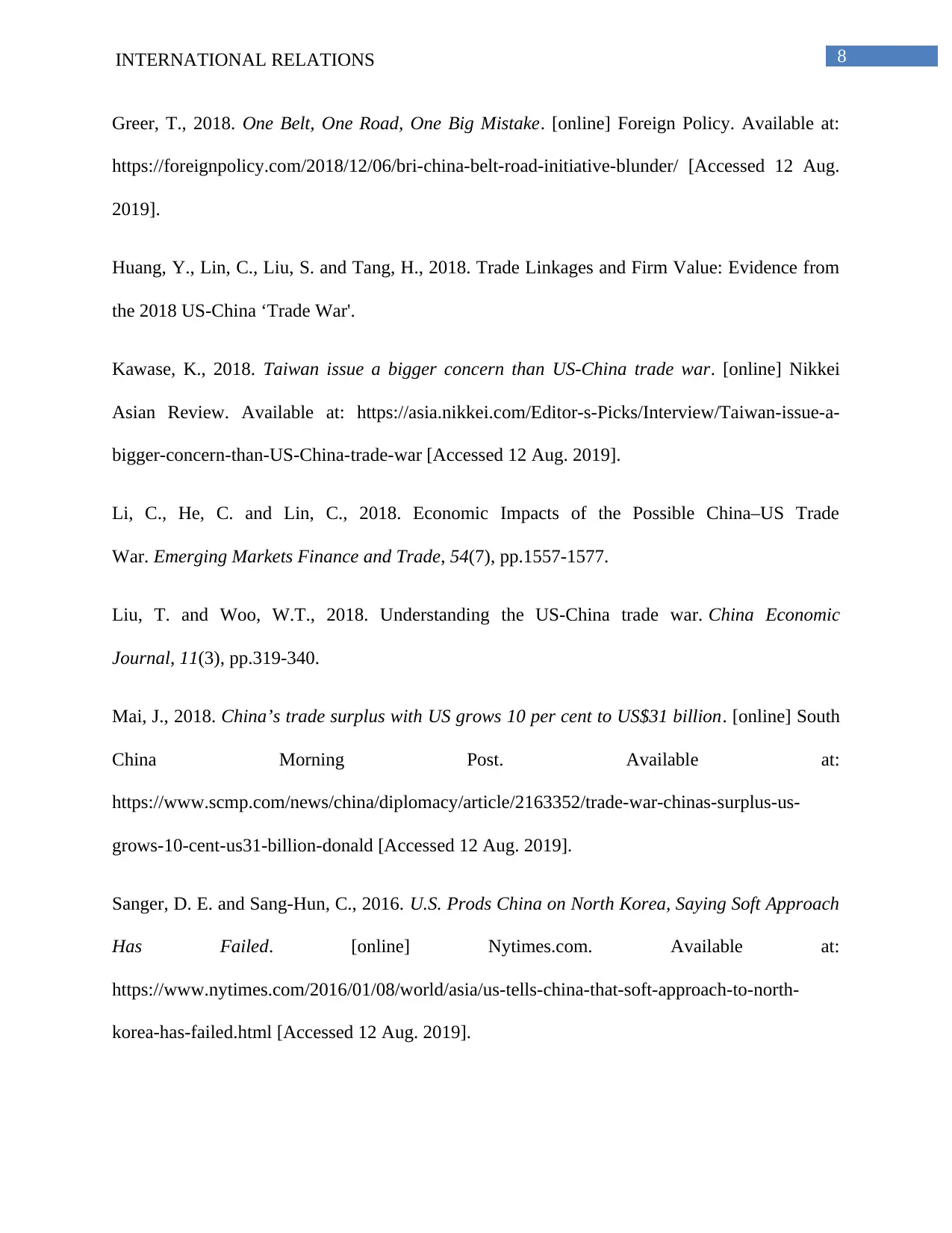
8INTERNATIONAL RELATIONS
Greer, T., 2018. One Belt, One Road, One Big Mistake. [online] Foreign Policy. Available at:
https://foreignpolicy.com/2018/12/06/bri-china-belt-road-initiative-blunder/ [Accessed 12 Aug.
2019].
Huang, Y., Lin, C., Liu, S. and Tang, H., 2018. Trade Linkages and Firm Value: Evidence from
the 2018 US-China ‘Trade War'.
Kawase, K., 2018. Taiwan issue a bigger concern than US-China trade war. [online] Nikkei
Asian Review. Available at: https://asia.nikkei.com/Editor-s-Picks/Interview/Taiwan-issue-a-
bigger-concern-than-US-China-trade-war [Accessed 12 Aug. 2019].
Li, C., He, C. and Lin, C., 2018. Economic Impacts of the Possible China–US Trade
War. Emerging Markets Finance and Trade, 54(7), pp.1557-1577.
Liu, T. and Woo, W.T., 2018. Understanding the US-China trade war. China Economic
Journal, 11(3), pp.319-340.
Mai, J., 2018. China’s trade surplus with US grows 10 per cent to US$31 billion. [online] South
China Morning Post. Available at:
https://www.scmp.com/news/china/diplomacy/article/2163352/trade-war-chinas-surplus-us-
grows-10-cent-us31-billion-donald [Accessed 12 Aug. 2019].
Sanger, D. E. and Sang-Hun, C., 2016. U.S. Prods China on North Korea, Saying Soft Approach
Has Failed. [online] Nytimes.com. Available at:
https://www.nytimes.com/2016/01/08/world/asia/us-tells-china-that-soft-approach-to-north-
korea-has-failed.html [Accessed 12 Aug. 2019].
Greer, T., 2018. One Belt, One Road, One Big Mistake. [online] Foreign Policy. Available at:
https://foreignpolicy.com/2018/12/06/bri-china-belt-road-initiative-blunder/ [Accessed 12 Aug.
2019].
Huang, Y., Lin, C., Liu, S. and Tang, H., 2018. Trade Linkages and Firm Value: Evidence from
the 2018 US-China ‘Trade War'.
Kawase, K., 2018. Taiwan issue a bigger concern than US-China trade war. [online] Nikkei
Asian Review. Available at: https://asia.nikkei.com/Editor-s-Picks/Interview/Taiwan-issue-a-
bigger-concern-than-US-China-trade-war [Accessed 12 Aug. 2019].
Li, C., He, C. and Lin, C., 2018. Economic Impacts of the Possible China–US Trade
War. Emerging Markets Finance and Trade, 54(7), pp.1557-1577.
Liu, T. and Woo, W.T., 2018. Understanding the US-China trade war. China Economic
Journal, 11(3), pp.319-340.
Mai, J., 2018. China’s trade surplus with US grows 10 per cent to US$31 billion. [online] South
China Morning Post. Available at:
https://www.scmp.com/news/china/diplomacy/article/2163352/trade-war-chinas-surplus-us-
grows-10-cent-us31-billion-donald [Accessed 12 Aug. 2019].
Sanger, D. E. and Sang-Hun, C., 2016. U.S. Prods China on North Korea, Saying Soft Approach
Has Failed. [online] Nytimes.com. Available at:
https://www.nytimes.com/2016/01/08/world/asia/us-tells-china-that-soft-approach-to-north-
korea-has-failed.html [Accessed 12 Aug. 2019].
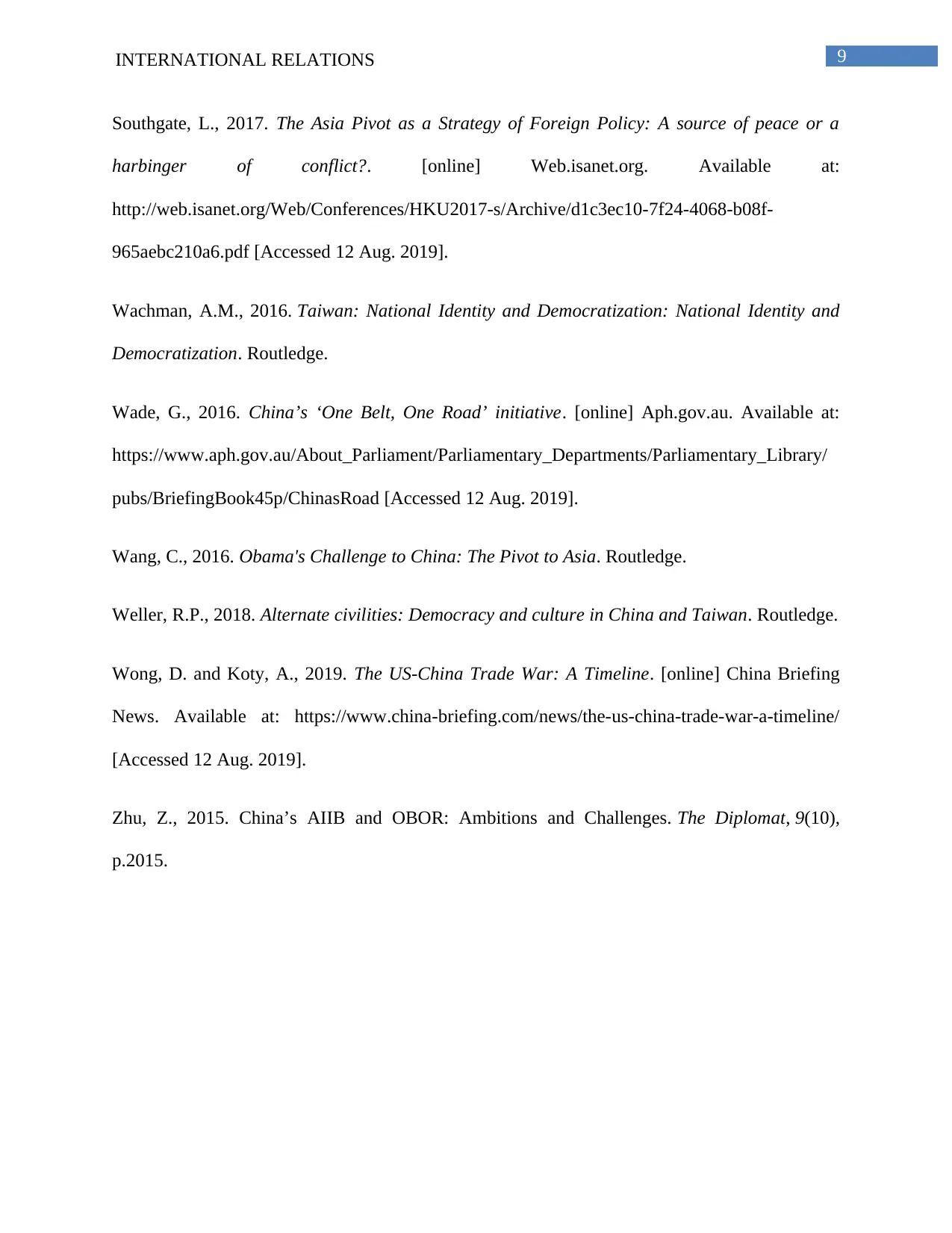
9INTERNATIONAL RELATIONS
Southgate, L., 2017. The Asia Pivot as a Strategy of Foreign Policy: A source of peace or a
harbinger of conflict?. [online] Web.isanet.org. Available at:
http://web.isanet.org/Web/Conferences/HKU2017-s/Archive/d1c3ec10-7f24-4068-b08f-
965aebc210a6.pdf [Accessed 12 Aug. 2019].
Wachman, A.M., 2016. Taiwan: National Identity and Democratization: National Identity and
Democratization. Routledge.
Wade, G., 2016. China’s ‘One Belt, One Road’ initiative. [online] Aph.gov.au. Available at:
https://www.aph.gov.au/About_Parliament/Parliamentary_Departments/Parliamentary_Library/
pubs/BriefingBook45p/ChinasRoad [Accessed 12 Aug. 2019].
Wang, C., 2016. Obama's Challenge to China: The Pivot to Asia. Routledge.
Weller, R.P., 2018. Alternate civilities: Democracy and culture in China and Taiwan. Routledge.
Wong, D. and Koty, A., 2019. The US-China Trade War: A Timeline. [online] China Briefing
News. Available at: https://www.china-briefing.com/news/the-us-china-trade-war-a-timeline/
[Accessed 12 Aug. 2019].
Zhu, Z., 2015. China’s AIIB and OBOR: Ambitions and Challenges. The Diplomat, 9(10),
p.2015.
Southgate, L., 2017. The Asia Pivot as a Strategy of Foreign Policy: A source of peace or a
harbinger of conflict?. [online] Web.isanet.org. Available at:
http://web.isanet.org/Web/Conferences/HKU2017-s/Archive/d1c3ec10-7f24-4068-b08f-
965aebc210a6.pdf [Accessed 12 Aug. 2019].
Wachman, A.M., 2016. Taiwan: National Identity and Democratization: National Identity and
Democratization. Routledge.
Wade, G., 2016. China’s ‘One Belt, One Road’ initiative. [online] Aph.gov.au. Available at:
https://www.aph.gov.au/About_Parliament/Parliamentary_Departments/Parliamentary_Library/
pubs/BriefingBook45p/ChinasRoad [Accessed 12 Aug. 2019].
Wang, C., 2016. Obama's Challenge to China: The Pivot to Asia. Routledge.
Weller, R.P., 2018. Alternate civilities: Democracy and culture in China and Taiwan. Routledge.
Wong, D. and Koty, A., 2019. The US-China Trade War: A Timeline. [online] China Briefing
News. Available at: https://www.china-briefing.com/news/the-us-china-trade-war-a-timeline/
[Accessed 12 Aug. 2019].
Zhu, Z., 2015. China’s AIIB and OBOR: Ambitions and Challenges. The Diplomat, 9(10),
p.2015.
1 out of 10
Related Documents
Your All-in-One AI-Powered Toolkit for Academic Success.
+13062052269
info@desklib.com
Available 24*7 on WhatsApp / Email
![[object Object]](/_next/static/media/star-bottom.7253800d.svg)
Unlock your academic potential
© 2024 | Zucol Services PVT LTD | All rights reserved.





